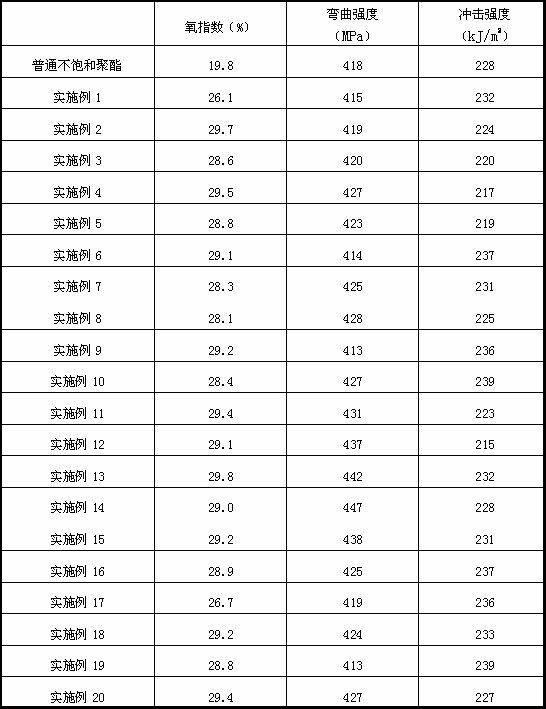Method for synthesizing reactive halogen-free flame-retardant unsaturated polyester resin
The technology of a polyester resin and a synthesis method, which is applied in the field of preparation of polymer compounds, can solve the problems of increased flexibility of products, sticky surface of resin castings, large amount of escape, etc., and achieves improved mechanical properties, good product quality, and improved preparation. simple craftsmanship
- Summary
- Abstract
- Description
- Claims
- Application Information
AI Technical Summary
Problems solved by technology
Method used
Image
Examples
Embodiment 1
[0030] (1) Add 100 grams of ethylene glycol and 80 grams of CEPPA into a 1000ml three-neck flask equipped with a stirrer, thermocouple and rectification tower, and react at 140°C to 160°C for 3 to 5 hours. The prepolymer 1 was obtained after reacting at ℃ for 2-4 hours, and cooled down to room temperature for use.
[0031] (2) Add 80 grams of 1,2-propanediol, 20 grams of diethylene glycol, 210 grams of maleic anhydride, and 40 grams of phthalate in another 1000ml three-necked flask with a stirrer, a thermocouple and a rectifying tower Acid anhydride, 0.2 g of dibutyltin oxide, 20 g of diphenyl dihydroxysilane, 0.07 g of hydroquinone, heat up to 140°C, keep warm for 1 hour, gradually heat up to 200°C in 6-8 hours, keep warm for 2-4 Add all the prepolymer 1 obtained in (1), gradually heat up to 200°C, react for 1 hour and then vacuumize under reduced pressure, the vacuum degree is -0.093MPa, until the acid value of the resin drops to 30-40mgKOH / g for the reaction At the end poi...
Embodiment 2
[0033] (1) Add 140 grams of ethylene glycol, 10 grams of neopentyl glycol, and 200 grams of CEPPA in a 1000ml three-necked flask equipped with a stirrer, a thermocouple and a rectification tower, and react at 140°C to 160°C for 3 to 5 hours. - 0.093MPa vacuum degree, react at 160°C for 2 to 4 hours to obtain prepolymer 1, cool down to room temperature for use.
[0034] (2) Add 150 grams of 1,2-propanediol, 300 grams of maleic anhydride, 20 grams of isophthalic acid, and 10 grams of phthalic acid in another 1000ml three-necked flask with a stirrer, thermocouple and rectification tower Acid anhydride, 20 grams of adipic acid, 0.3 grams of dibutyltin oxide, 0.2 grams of butyltin dilaurate, 70 grams of diphenyl dihydroxysilane, 0.2 grams of hydroquinone, heat up to 140 ° C, keep warm for 1 hour, use 6 ~ Gradually raise the temperature to 200°C for 8 hours, keep it warm for 2 to 4 hours, add all the prepolymer 1 obtained in (1), gradually heat up to 200°C, react for 1 hour and then...
Embodiment 3
[0036](1) Add 130 grams of ethylene glycol, 10 grams of diethylene glycol, and 150 grams of CEPPA into a 1000ml three-neck flask equipped with a stirrer, a thermocouple and a rectification tower, and react at 140°C to 160°C for 3 to 5 hours. - 0.093MPa vacuum degree, react at 160°C for 2 to 4 hours to obtain prepolymer 1, cool down to room temperature for use.
[0037] (2) Add 140 grams of 1,2-propanediol, 10 grams of neopentyl glycol, 320 grams of maleic anhydride, 0.4 grams of dibutyl oxide in another 1000ml three-necked flask with a stirrer, thermocouple and rectification tower Tin, 23 grams of diphenyldihydroxysilane, 0.1 gram of hydroquinone, heating up to 140 ° C, heat preservation for 1 hour, gradually warming up to 200 ° C in 6 to 8 hours, heat preservation for 2 to 4 hours, adding (1) obtained All prepolymers 1, gradually heated up to 200°C, and after 1 hour of reaction, depressurized and vacuumed, with a vacuum degree of -0.093MPa, until the acid value of the resin d...
PUM
 Login to View More
Login to View More Abstract
Description
Claims
Application Information
 Login to View More
Login to View More - R&D
- Intellectual Property
- Life Sciences
- Materials
- Tech Scout
- Unparalleled Data Quality
- Higher Quality Content
- 60% Fewer Hallucinations
Browse by: Latest US Patents, China's latest patents, Technical Efficacy Thesaurus, Application Domain, Technology Topic, Popular Technical Reports.
© 2025 PatSnap. All rights reserved.Legal|Privacy policy|Modern Slavery Act Transparency Statement|Sitemap|About US| Contact US: help@patsnap.com


